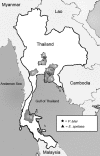Survey for bat lyssaviruses, Thailand
- PMID: 15752440
- PMCID: PMC3320458
- DOI: 10.3201/eid1102.040691
Survey for bat lyssaviruses, Thailand
Abstract
Surveillance for lyssaviruses was conducted among bat populations in 8 provinces in Thailand. In 2002 and 2003, a total of 932 bats of 11 species were captured and released after serum collection. Lyssavirus infection was determined by conducting virus neutralization assays on bat serum samples. Of collected samples, 538 were either hemolysed or insufficient in volume, which left 394 suitable for analysis. These samples included the following: Pteropus lylei (n = 335), Eonycteris spelaea (n = 45), Hipposideros armiger (n = 13), and Rousettus leschennaulti (n = 1). No serum samples had evidence of neutralizing antibodies when tested against rabies virus. However, 16 samples had detectable neutralizing antibodies against Aravan virus, Khujand virus, Irkut virus, or Australian bat lyssavirus; all were specifically associated with fruit bats P. lylei (n = 15) and E. spelaea (n = 1). These results are consistent with the presence of naturally occurring viruses related to new putative lyssavirus genotypes.
Figures
Similar articles
-
[Bat lyssavirus in Thailand].J Med Assoc Thai. 2005 Jul;88(7):1011-4. J Med Assoc Thai. 2005. PMID: 16241035 Thai.
-
Evidence of Lagos bat virus circulation among Nigerian fruit bats.J Wildl Dis. 2010 Jan;46(1):267-71. doi: 10.7589/0090-3558-46.1.267. J Wildl Dis. 2010. PMID: 20090042
-
Targeted surveillance for European bat lyssaviruses in English bats (2003-06).J Wildl Dis. 2009 Oct;45(4):1030-41. doi: 10.7589/0090-3558-45.4.1030. J Wildl Dis. 2009. PMID: 19901379
-
Bats and lyssaviruses.Adv Virus Res. 2011;79:239-89. doi: 10.1016/B978-0-12-387040-7.00012-3. Adv Virus Res. 2011. PMID: 21601050 Review.
-
Molecular epidemiology of lyssaviruses in Eurasia.Dev Biol (Basel). 2008;131:125-31. Dev Biol (Basel). 2008. PMID: 18634471 Review.
Cited by
-
Correlates of viral richness in bats (order Chiroptera).Ecohealth. 2009 Dec;6(4):522-39. doi: 10.1007/s10393-009-0263-8. Epub 2010 Jan 5. Ecohealth. 2009. PMID: 20049506 Free PMC article.
-
Ecological factors associated with European bat lyssavirus seroprevalence in spanish bats.PLoS One. 2013 May 20;8(5):e64467. doi: 10.1371/journal.pone.0064467. Print 2013. PLoS One. 2013. PMID: 23700480 Free PMC article.
-
Synanthropy of wild mammals as a determinant of emerging infectious diseases in the Asian-Australasian region.Ecohealth. 2012 Mar;9(1):24-35. doi: 10.1007/s10393-012-0763-9. Epub 2012 Apr 24. Ecohealth. 2012. PMID: 22526750 Free PMC article.
-
Lyssavirus surveillance in bats, Bangladesh.Emerg Infect Dis. 2006 Mar;12(3):486-8. doi: 10.3201/eid1203.050333. Emerg Infect Dis. 2006. PMID: 16704789 Free PMC article.
-
Bat lyssaviruses, northern Vietnam.Emerg Infect Dis. 2014 Jan;20(1):161-3. doi: 10.3201/eid2001.130813. Emerg Infect Dis. 2014. PMID: 24377728 Free PMC article. No abstract available.
References
Publication types
MeSH terms
Substances
LinkOut - more resources
Full Text Sources


